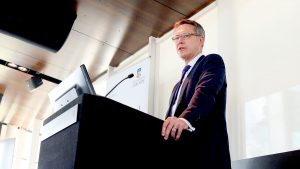The Australian Labor Party this week made its major policy announcement on climate change and renewable energy, to much public comment and debate.
The essential elements of the announcement were
- Ensure 50% of the nation’s electricity is sourced from renewable energy by 2030
- electricity generation will be covered by a carbon cap with each generator having a baseline. The total cap will reflect electricity’s share of carbon emissions. The ALP states it will implement the model proposed by the Australian Energy Market Commission [AEMC].
- Conduct an Electricity Modernisation Review [EMR] to report no later than the end of 2017. We think this is an excellent idea. A lot has changed since the National Electricity Market [NEM] was first created back in 1997.
- Create a framework for the withdrawal of existing generation plant.
- Increase energy efficiency
Comment
As an analyst with two decades of learning about electricity markets, and bearing in mind the technology changes that are happening around the world, the decarbonisation requirements outlined at the Paris Accord, and the age of the existing thermal generation fleet in Australia, we conclude that this policy is credible and appropriate, even if it is not ideal.
Leaving partisan politics to one side, we believe that a policy such as this is one that the industry could broadly support, because it is a policy that provides a planning base for both thermal generators and renewable generators, and is a policy that is completely appropriate for a country with the fuel, technology and economic resources that Australia possesses.
If we can spend $50 billion building 12 submarines we can certainly incentivise the private sector to spend some money building the next generation electricity system over the next 25 years.

A scheme that penalises carbon emissions is essential if there is a policy to increase renewable generation. That’s because without a cost (price or tax) on carbon the impact of new renewables is to push out the lowest emitting (and most expensive) thermal plant.
All over the world we see that wind pushes gas out of the generation merit order before it pushes out coal. Wind and solar push out black coal before they push out brown coal. Putting a cost on carbon makes it more likely that high emitting plant exits before low emitting plant.
An even better policy would see the carbon costs fixed at a dollar/per tonne estimate with the costs passed on to consumers incentivising energy efficiency (just like petrol taxes) and the carbon revenue going to the government.
The government could put the revenue back into subsidising storage at both the household and utility level (although its much more economic and efficient at the household level) and thereby making the move to 50 per cent renewables a much less technical challenge than it otherwise will be.
“The baseline scheme.
The AEMC sketched out this scheme in a submission to the Climate Change Authority [CCA].

In this scheme the total baseline CO2 emissions for the electricity sector are converted to an emissions intensity. Emissions intensity is defined as total emissions (MtCo2)/total electricity generation. This is commonly expressed as tonnes of CO2 per MWh and is a very well understood concept in the industry. Broadly speaking the NEM-wide intensity index is about 0.96 at the moment. Further details of the AEMC proposal include:
“Thermal generators with emissions intensities above the baseline, and who are covered by the safeguard mechanism, would be required to surrender sufficient AESCs to reduce their rate below the baseline.
– If the baseline is 900kg/MWh,then a thermal generator with an intensity of 1200kg/ MWh would need to procure and surrender 300 kg of credits for every MWh generated.
- Thermal generators with emissions intensities below the baseline, and who are covered by the safeguard mechanism, create AESCs equal to the difference between their emissions intensity and the baseline for every MWh produced.
– A CCGT emitting 500kg/MWh would produce 400kg of AESCs for every MWh.
- No AESC credits exist at the start of the compliance period, but are steadily created by low emitting generators and purchased by high emitting generators. If insufficient AESCs are being created relative to demand, the resulting increase in AESC prices would induce switching to lower emissions intensity technologies.
- As envisaged in the Department’s consultation paper, generators could also surrender eligible emissions offsets through the use of ACCUs generated by ERF projects.
- Multi-year compliance or banking and borrowing could be considered to promote flexibility for generators to comply, subject to any concerns around participants taking advantage of this flexibility to manipulate market outcomes.
- As a last resort, the regulator could apply to a court to have the obligation enforced or seek the application of a civil penalty (as per the consultation paper proposal).”
- Renewable energy generators could choose to sell into either the REC market or the AESC market. After 2030 when the REC scheme ends this provides a way forward for the renewable industry.
- The intensity baselines (total generation and total carbon emissions) could be updated at regular intervals to either allow for changes in consumption or changes in carbon emission targets.
Output and emissions
Our first chart shows output in calendar 2015 for most major power stations in the NEM together with the fuel. We don’t show wind or PV but we will return to these if time and space permit.

This chart is a familiar figure but the main learnings from it are that, of the five largest stations by output, three are brown coal and two are black coal.
Next we rearrange the data to show total emissions by power station. Again this is based on 2015 output and, if anything, coal’s share will have increased since. Note we certainly don’t have every power station in this list.

However, under the proposed scheme the way to look at the data is the net emissions over or below base line. In the chart below we show emissions relative to the NEM current baseline of 0.96. We also edited the list to only show companies with a significant loss (positive in the chart) or profit (negative in chart). These stations could be expected to be the major winners, losers and traders.

What should the price be?
This is where it gets interesting and we have to make some assumptions.
- we assume that all generators abide by the rules, there is no penalty price for non compliance because non compliance is against the law.
- We ignore rooftop PV, anything that qualifies for an SREC can’t participate in this scheme.
A two generator example
We start with a case where there is 200 MWh of unsatisfied demand which can be supplied by either brown coal and black coal. The emissions intensity index has been set at 1.125 which happens to be the average if both produce an equal amount. The brown coal generator has a variable cost (fuel + other ) of say $2.30 MWh (about that of LYA) and the black coal generator’s variable cost is say $13.5 MWh (about that of Bayswater).

Each generator has enough capacity to satisfy the entire demand. Before the carbon scheme is introduced its likely that the brown coal generator would produce 100 per cent of the marginal demand because its variable cost is lower.
Once the scheme starts, the brown coal generator has to buy enough credits to offset its output. The only potential seller of those credits is the black coal generator. This constraint means that each generator will produce the same amount. If the brown coal generator produces more than 50 per cent of the output it will not be able satisfy its legal obligation. If the black coal guy produces more than 50 per cent it will produce surplus carbon credits with zero value and its variable cost will be higher.
The price might be set where the variable cost of both producers including the carbon is equal. In this example this means the price would be about $44.8 and each makes the same profit. As far as we can see it doesn’t have to be the case that the carbon price is set where each generator has the same costs, it’s a matter of relative bargaining power. If price was set at short-run marginal cost, however, because in this case more of the demand is satisfied by a generator with higher variable costs (before carbon), total profits fall.

In this particular example one consequence would be that the brown coal generator would lose volume and therefore have less revenue to cover fixed costs.
Thoughts on the proposal
- Overall the big winners from this proposal would be low-emission generators, particularly Snowy Hydro but also combined cycle gas producers such as Darling Downs.
- It could be of big assistance to South Australia and make it far more likely that Pelican Point would be brought back into full operation. Gas-fired generation is declining in Australia because the cost of gas has gone up to export parity. As things stand at the moment it’s more valuable (just) to send the gas into the LNG market than to burn it for electricity. This scheme would provide more incentive for gas to be used for electricity.
- However the more important impact would be to force brown coal up the variable cost curve and probably see it lose volume. This would reduce the profit of brown coal generators making it more likely they would close.
- The scheme would require some extra accounting as we find it hard to see that the surplus would exactly equal the deficit.
- In addition, the government doesn’t raise any revenue from the scheme.
- Finally the costs of carbon really should be borne by the consumer and overall energy efficiency benefits if the marginal cost of carbon is passed onto the electricity consumer.
- As such we don’t think this scheme is as useful as a carbon tax (fixed price on carbon) where the revenue is received by the government, just like a petrol tax. Still, it’s a darn sight better than nothing.
50% renewable generation by 2030
Your correspondent took a look at this in 2015 when working for an investment bank. In this section we are just going to extract a few tables and conclusions from that analysis.
In summary we think its technically and economically feasible (cost would likely be < A $100bn spread over 15 years).



As we know much of the existing generation fleet will have to be replaced by 2030 under any scenario. So the cost needs to be measured against the cost of building new thermal generation. That cost would likely have to factor in a carbon cost and, in any event, no one in the industry presently believes there is any realistic chance of building new coal-fired plants in the NEM.
A bigger role for the CEFC because reverse auctions are cheaper
The cost of capital and capital costs are by far the largest drivers of the cost of renewable energy. The risk associated with uncertain REC and even black energy prices makes the cost of capital [WACC] far higher than it needs to be. We are confident that if the quantity of new renewable each year was fixed by a series of reverse auctions based on 15-20 year contracts of either fixed or real locked in guaranteed prices then the renewable energy would be supplied at lower cost than under the present system. A fixed supply of 3-5 GW per year over a 10 year period would also enable the industry to rapidly move down the learning curve.
Storage and flexibility would be tested
As renewable penetration increases, the strains on existing baseload plant will increase and at some point the system will be unable to cope without help. The system at the moment copes quite well. For instance on July 22, demand over the day varied by 4GW and wind output declined from 2.9GW to 0.6GW but the system was still able to cope via an increase in hydro and coal.

Even so, as the penetration of renewables increases and total demand probably also increase the volatility of the generation that can produced “on demand”. We estimate that by 2030, and assuming 50 per cent renewables penetration, the remaining thermal generation would have to cope with an average demand swing during the day of 14GW. We don’t think that is realistic at all.

Nor would it be a good idea to build 1000s of MW to open cycle or combined cycle of gas to deal with the problem. For one thing the gas supply is uncertain and for another the carbon emissions defeat the purpose.
Other solutions are nuclear and storage. In our view, storage at both the utility and household level is the appropriate answer but in saying that the industry must face up to the significant environmental challenges of disposing of lithium batteries at the end of their life.







